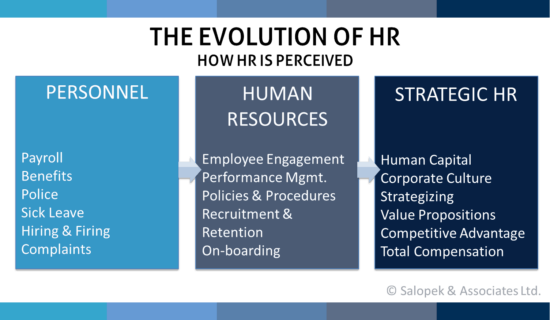
In recent years, Human Resources has gained increasingly more involvement at the strategic level. We have seen the introduction of new titles (VP and Director of HR), representation at the Board level, and the concept of competitive advantage through incorporating HR into the strategic plan.
So. What does this mean?
This is drastically different to the ways of the past. How about when HR was just a back-room function, manning payroll or overseeing terminations? Going back even further, we see the huge contrast to Human Resources pre-World War 1. To grasp how far HR has developed in the last 300 years, here’s a brief historical overview:
With the Industrial Revolution (late 1700s, early 1800s) came Personnel Management, to oversee the wages and welfare of the masses moving into the industrialized workplace. Over these years, Labour Unions grew exponentially and workers protested against the long hours, low wages and poor treatment – ultimately causing very political work environments. Thus, the Personnel and industrial relations department emerged in order to address these politics. After 1850, Human Resource Management evolved drastically as the focus shifted from increasing workers’ productivity to increasing workers’ efficiency through greater work satisfaction (Hawthorne studies by Elton Mayo and Fritz Roethlisberger, 1927 – 1940). Although the department was still very much administrative and process-oriented, no longer were employees seen as interchangeable. Instead the Industrial Relations department concentrated on solving employee problems and dealing with ethical issues – the idea of fixing something that is broken rather than replacing. After WWII organizations became more aware of human capital issues, recognizing the importance of employee morale in the success of organizations.
Today, HR has taken yet another step forward. The development of Human Resource Information Systems (HRIS) has hugely streamlined the administration side of HR, reducing the time spent on record-keeping, and overall allowing HR to become more strategic. Now it not only acts as a core business operation but is viewed as a competitive advantage, effective in aligning individual goals and objectives with corporate goals and objectives.
And this is exactly how we at Salopek & Associates feel about HR! The strategic element is of most value to businesses today and we are excited to see more and more organizations implement it in these ways:
- Strategic Business Planning – Ensuring employees are being utilized in a way that aligns with the organization’s goals. This is achieved through clearly communicating the organization’s vision, and recruiting according to that vision.
- Organizational Change Facilitation – Ensuring that all employees are equipped with the skills and information needed to carry out the task and adapt to change as required. This means getting the team on board in order to achieve desired change within the organization.
- Employee Advocacy – Knowing your people and understanding the unique talents and aspirations of each employee will allow an organization to create environments that enhance their productivity and allow each individual success in their role.
And the evolution continues. No doubt you have heard the many new titles for the HR department… People and Culture, Employee Services, Talent Management or even the divided departments of People Support and People Analytics*.
Call it what you will, the Human Resources function has developed immensely over the years and nowadays gains its value through representation in an organization’s Strategic Planning. It may take a few more years before employees no longer think of HR as the workforce police, but as we continue to demonstrate our value through ROIs, metrics and business success you can expect to see Human Resources obtain an even larger presence at the board table.
*As suggested by Bernard Marr, Why We No Longer Need HR Departments.

